Studio Visit
Inside Rosa Loy’s Painted World of Folkloric, Witty Women
The artists new exhibition "Glade" is on view at Michael Kohn in Los Angeles.
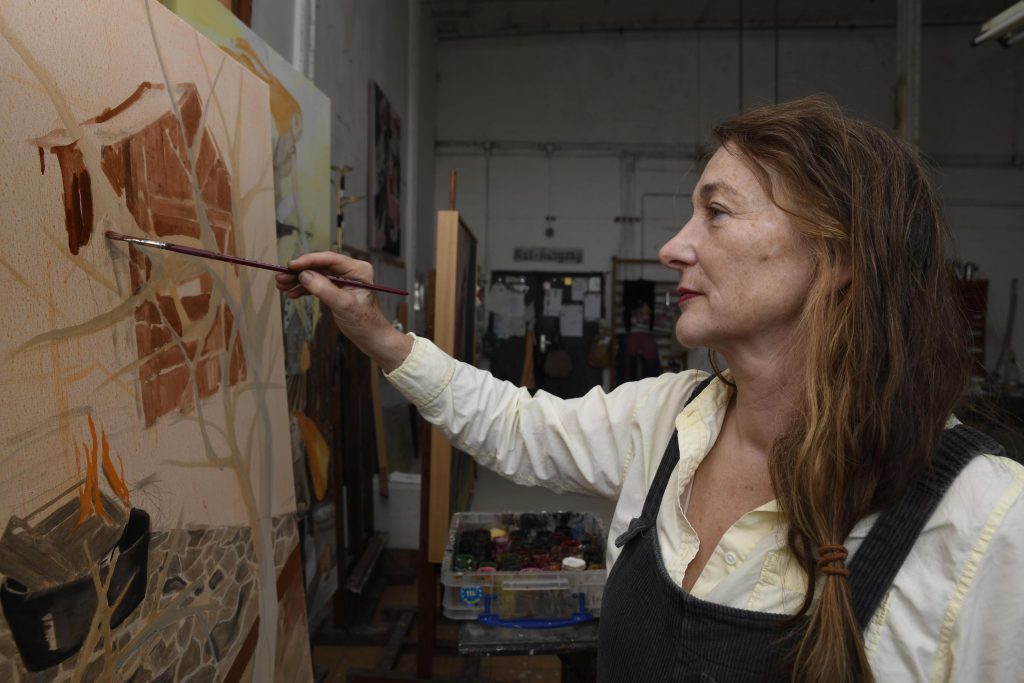
Every day artist Rosa Loy rides her bicycle 10 kilometers through Leipzig from her home to the studio she has kept since 1994. “My mind clears of everything I’ve been thinking of at home,” she said during a recent conversation. “I go into the studio, have a tea, start to paint, and see what’s coming in. I wait for a tingling feeling like someone is watching me from behind. That’s where my ideas come from.”
The studio space is a former spinning factory where 3,000 women were employed until 1990. Today the space includes over a hundred artist studios, restaurants, and shops—but the history of the space has special resonance for Loy, whose paintings celebrate women, in folkloric visions touched by a surreal sense of mischief and Central European traditions.
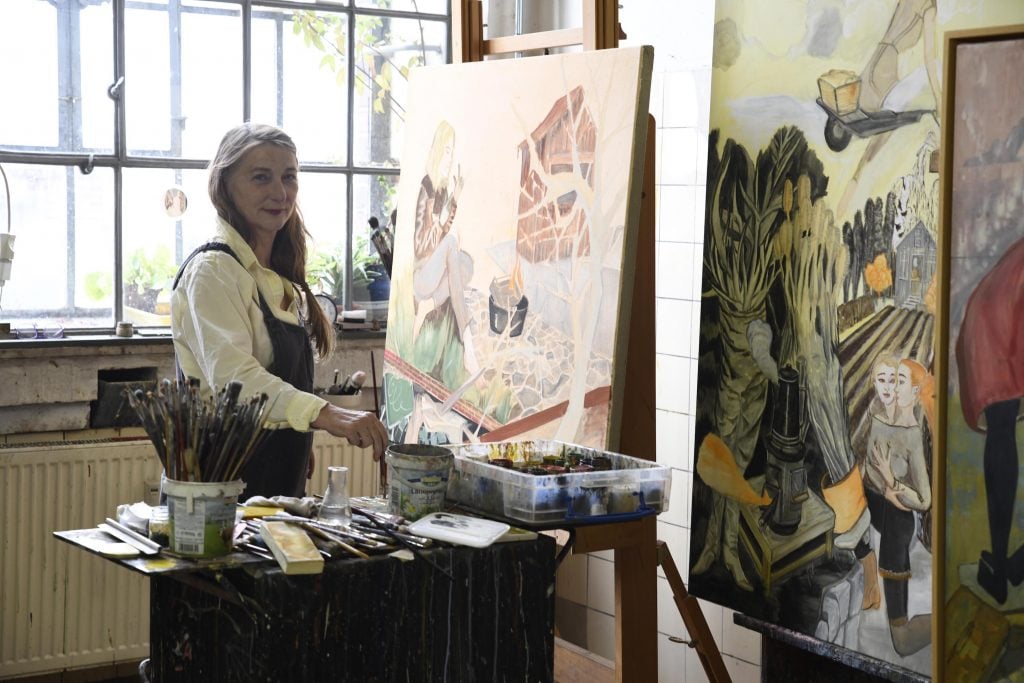
Rosa Loy in her Leipzing studio, 2024. Courtesy of the artist and Michael Kohn Gallery.
Loy was born in Zwickau in East Germany. Passionate about both painting and plants, Loy studied horticulture and then attended art school. She was one of only a handful of women artists to come out of the influential New Leipzig School of artists (her husband is the artist Neo Rauch). Loy, however, has always drawn inspiration from women artists, citing Leonora Carrington and Dorothea Tanning as specific influences. Her fantastical world of women has deeply influenced a younger generation of artists whose works explore feminine experience through a surrealist lens.
Loy’s most recent exhibition “Glade” is on view at Michael Kohn in Los Angeles. A new series of casein paintings explore the idea of lichtung—the German word for a clearing in the forest—translating, in Loy’s work, into uncanny tableaux that embrace the elements.
Recently we spoke to the artist from her base in Leipzig and learned more about the inspirations behind her imaginative works.
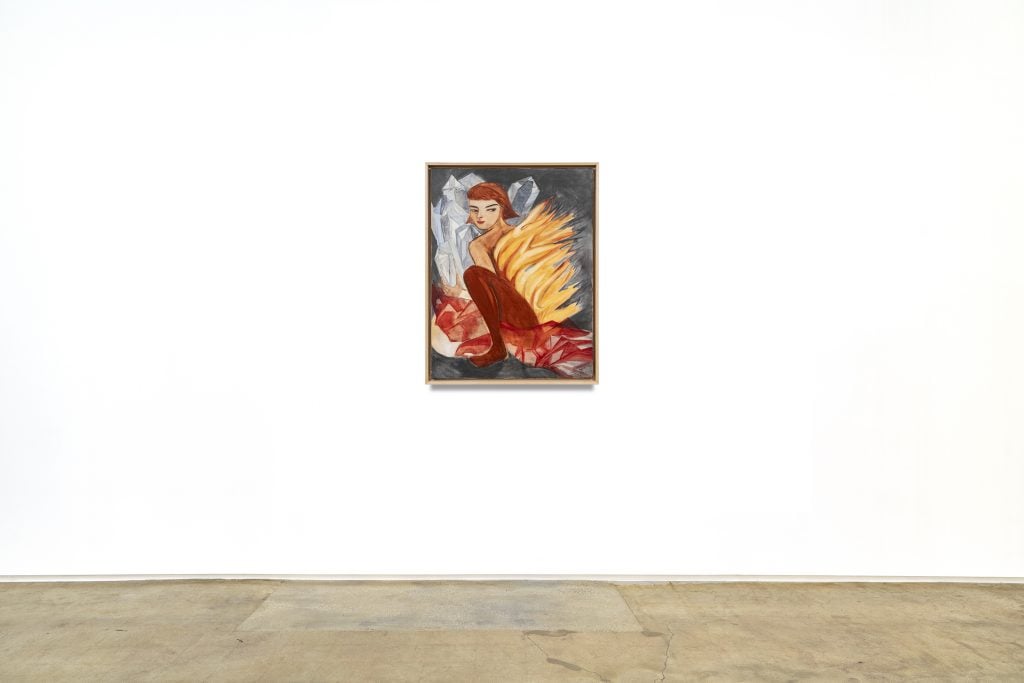
Rosa Loy, Feuer (2023). Courtesy of the artist and Michael Kohn Gallery.
Right now, your exhibition “Glade” is up at Michael Kohn in Los Angeles. Can you tell me about the new work and what you were thinking about?
I don’t know if you have this word in English—lichtung. If you go to a forest full of trees, and it’s dark and you find one place where the sun is shining down very brightly on the grass, and you can lie there—that is lichtung. It is a place of surprise, light, and well-being, where you feel carried into another world. We live in an interesting moment when we need light and good things in our lives to go forward, which is what I was thinking about making these works.
How do you go about starting a new body of work? Are your series of works connected?
In any single moment, many moments are meeting. I think of my paintings like a diary but on canvas. Sometimes I’m thinking of something I’ve read, or an old song or photographs when I start painting. I have a sense of remembering or a feeling, or a problem that the canvas helps me find a solution for.
The time of year affects my work, too. We have seasons in Germany and whether I make a painting in spring or in winter or on a hot summer day changes the colors of the works. The paintings in “Glade” were made during the fall and winter so there are a lot of earthy colors and some cold yellows. These works are very colorful, but in the end, they are longing for summer. All these paintings are very subjective. I don’t look out to the world for inspiration but try to put my little world into the paintings.
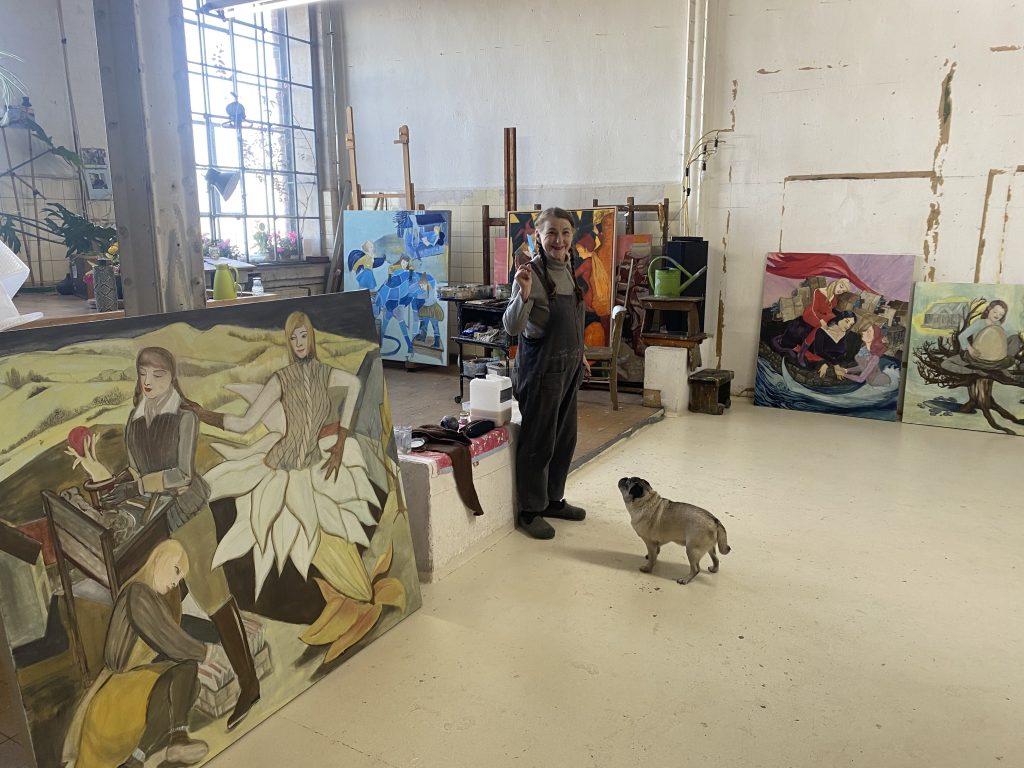
Rosa Loy in her Leipzing studio, 2024. Courtesy of the artist and Michael Kohn Gallery.
I read that you were trained and worked as a horticulturist before you became a painter. Is that true? Do you have certain plants you like to paint?
Yes, yes. Horticulture was my first profession. I studied horticulture and worked in that field for five years. It was the rule in the former GDR where I grew up, that after you earned a degree, you had to work in the field for four or five years, and then you could go back to school again if you wanted and study something new.
I come from a family of gardeners, too. I always was painting at the same time, but even when I decided to return to school for painting, I thought, ok if I’m not good at this, I can go work as a gardener again. Women always want to have another option, keeping in mind I’m taking care of the family and kids and need to have enough money to raise them.
As for the plants in my paintings, sometimes I have mushrooms or little trees with the figure of a woman or faces. I grew up not as Christian, but with a belief in nature. Even now, I have plants and chickens and eggs and birds and am a beekeeper.
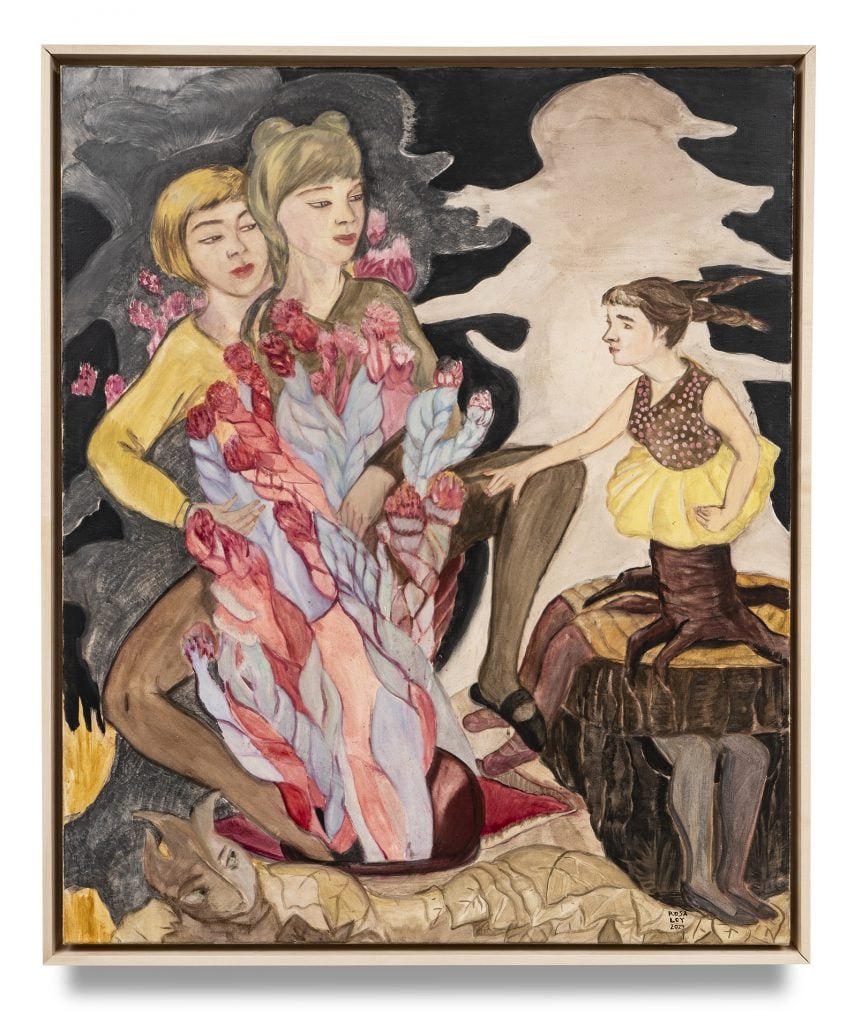
Rosa Loy, Nahe (2023). Courtesy of the artist and Michael Kohn Gallery.
All these works are made with casein which is an ancient water-based form of paint derived from milk. Why did you decide to use those materials?
It’s a very, very old technique that I discovered in Italy. I first saw it in churches in Florence. It was used especially for painting frescos on church walls. Casein is made from milk powder mixed with ammonium carbonate. It becomes a very strong glue that becomes the glue for the pigments—I use oil color and turpentine and it becomes something fast and light. It’s very flat and soft and shiny.
Your paintings are always filled with women—men really don’t seem to exist in your painted world. Why is that?
I grew up in a society where women and men were really believed to be equals. I was raised the same as my brother, but that’s not the normal state of the world. I decided I wanted to paint women and share their special beauty, wisdom, and forms of knowledge. It’s been a man’s world for over 2000 years in many ways. Now with how the world is changing, we need the systems and knowledge of women to survive, I believe. With my little paintings, I hope women can feel brave and proud and go their own way. At the same time, I find women very beautiful. As a woman, I can decode women, I can read them. Women’s faces and gestures are interesting to me. I started making these paintings a long time ago, but I’m not finished with them. I always find some new story to tell.
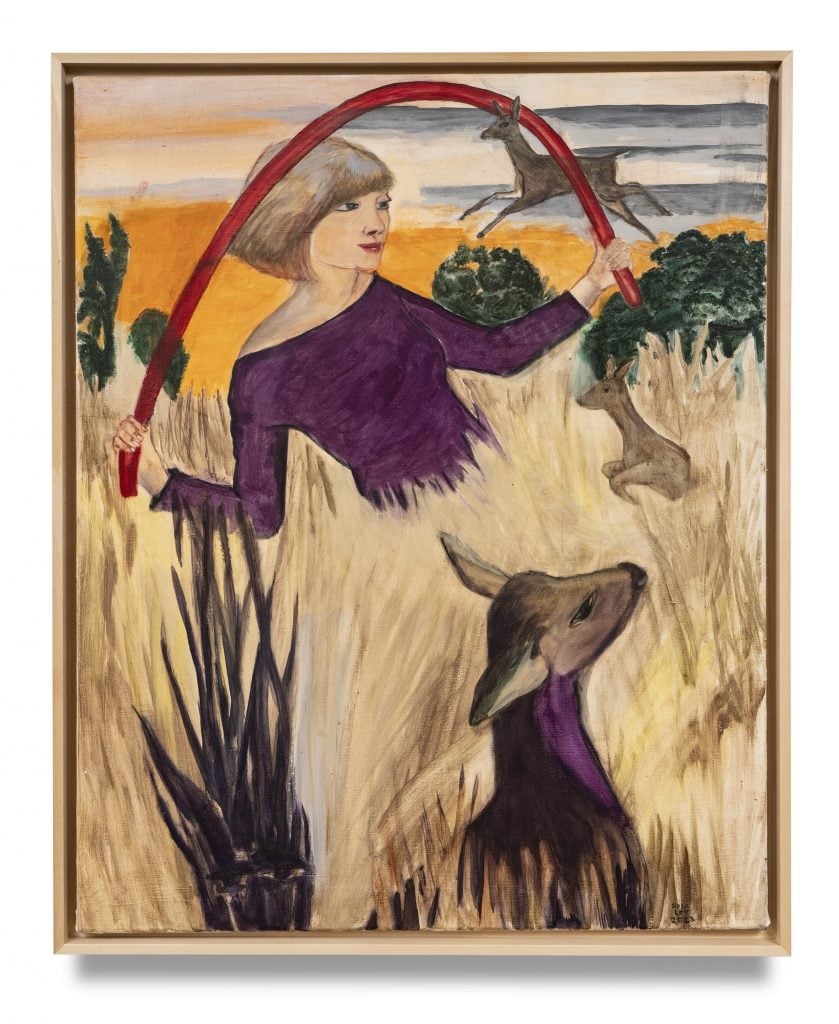
Rosa Loy, Imfeld (2022). Courtesy of the artist and Michael Kohn Gallery.
Are the sprites and fairies that appear in your works good or bad?
I don’t like to say what’s what, that this is the right and this is the wrong interpretation of a painting. What I love most is when people tell me what they see in my paintings—it’s often a very different story than what I had in mind because everyone brings their history and experiences. Some people hate birds because they shit on their heads. I love birds because they sing wonderful songs. There are lots of possibilities for my paintings.
The women in your paintings often have this magically long and thick hair—sometimes little beings are hiding in their hair, even.
Hair is a connection to nature—our hair falls into the world around us. For women, it’s very. Important. We play with our hair. Women can spend a lifetime getting their hair done, going to the hairdresser. We manipulate it with hairspray. Women brush and braid each other’s hair.
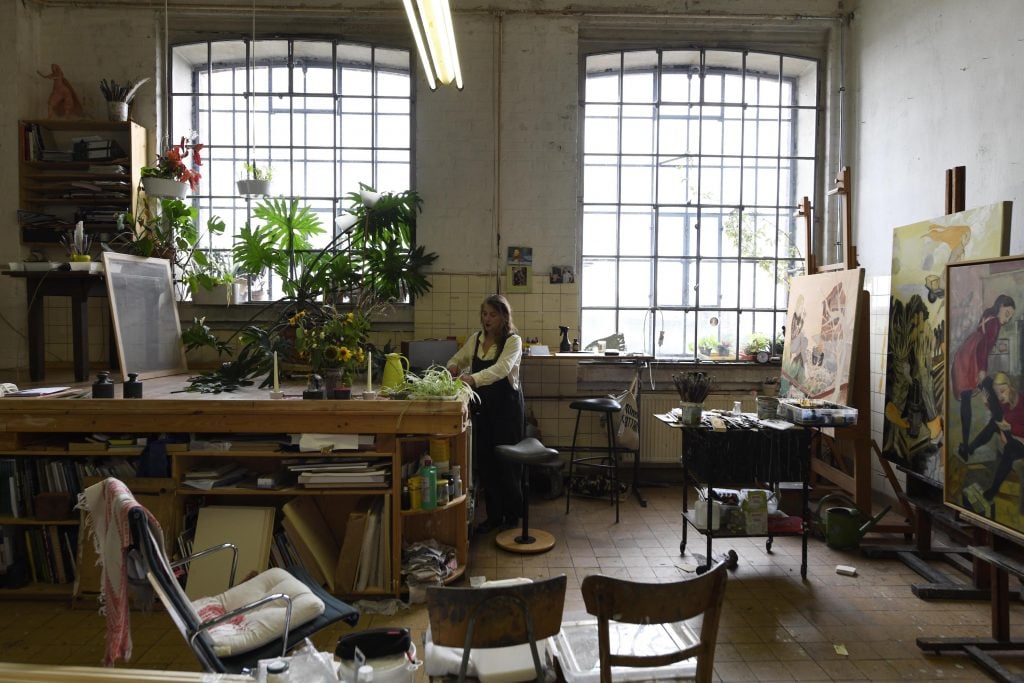
Rosa Loy in her Leipzing studio, 2024. Courtesy of the artist and Michael Kohn Gallery.
How does folklore emerge in your works?
It comes from my subconsciousness. I grew up with these fairy tales from Hans Christian Anderson and Russian fairytales. It’s like kids today with Harry Potter. It comes through from time to time in the paintings in new and old ways. It’s not illustration, but just part of my history that comes to the surface.
Who are the artists you’re most influenced by?
I love the Surrealist women. Leonora Carrington, Dorothea Tanning, Toyen. We all love Max Beckmann. I’m also very influenced by a younger generation of women artists. In the past 10 years, a new generation of wonderful women artists have emerged and they paint in a different way. They’ve found their own way and I enjoy it so much. Women bring so much beauty and hope into the world. With my paintings, I hope I can show some of that beauty that we need so much in the world right now.





